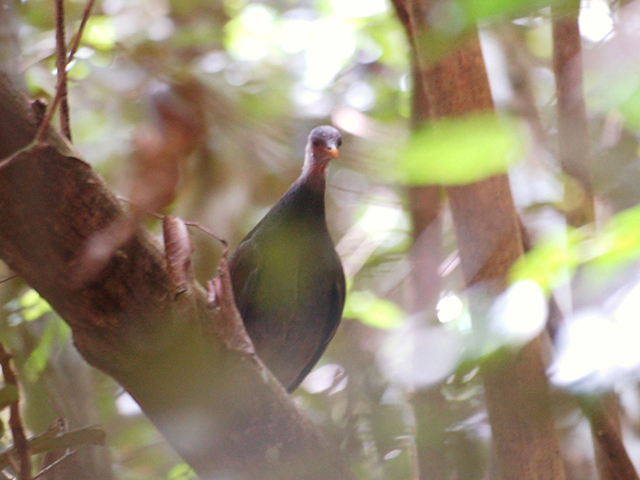
Biodiversity Conservation
The globally endangered Polynesian megapode (Megapodius pritchardii) is an unusual ground-dwelling bird which is endemic to Tonga. In Latin, 'megapodius' means 'big-footed' which is no doubt a reference to the bird's robust legs, used to dig nests and burrows underground. In Tonga, the Polynesian megapode is known as the 'malau'.

Unlike most birds, the Polynesian megapode does not incubate eggs using body heat. Instead it buries them in warm volcanic sands where they are incubated by geothermal sources. This very specific tactic, while effective from a time-management perspective, limits the bird to settlements on volcanic islands.
Fossil records indicate that in pre-human times there were four or five species of megapode in existence across Tonga, Fiji, New Caledonia, Samoa and Niue. Currently the Polynesian megapode, endemic to Tonga, is the only species that survives in Polynesia.
The cause of these extinctions was undoubtedly the arrival of humans on the islands, who hunted (and continue to hunt) the birds for meat and eggs. Invasive species, such as rats and cats, probably didn't have a significant impact on the initial decline in numbers, but they have certainly impeded subsequent attempts to re-establish the population.
In the early 1990s, efforts were made to boost the numbers of the Polynesian megapode by translocating eggs and chicks from its single and threatened population in Niuafo'ou to sites on the remote and uninhabited islands of Fonualei and Late.
In September of last year, SPREP conducted a field survey led by top international ornithologist, Dr David J Butler, to assess the status of these colonies. The team were pleased to discover that the population on Fonualei had possibly doubled during the past ten years – increasing from around 300–500 adult individuals in 2003 to approximately 1,000 in 2013. Unfortunately however, the survey team did not observe any Polynesian megapodes on Late, suggesting that the translocation programme has failed in this location.
Later this year, SPREP is planning a survey on the island of Niuafo'ou where preliminary work has suggested that the local community is still collecting eggs for customary purposes. A big challenge for the project will be to assess whether the current rates of egg collection are sustainable. If not, work will be undertaken at local and national level to find a way to sustainably manage this activity.
SPREP's survey work of the Polynesian megapode in Tonga is carried out through the Global Environment Facility - Pacific Alliance for Sustainability Integrated Island Biodiversity project executed by SPREP in partnership with the Tonga's Ministry of Land, Environment, Climate Change and Natural Resources and implemented by the United Nations Environment Programme.

The Polynesian megapode or 'malau'. Image (c) A.Goth
Unlike most birds, the Polynesian megapode does not incubate eggs using body heat. Instead it buries them in warm volcanic sands where they are incubated by geothermal sources. This very specific tactic, while effective from a time-management perspective, limits the bird to settlements on volcanic islands.
Fossil records indicate that in pre-human times there were four or five species of megapode in existence across Tonga, Fiji, New Caledonia, Samoa and Niue. Currently the Polynesian megapode, endemic to Tonga, is the only species that survives in Polynesia.
The cause of these extinctions was undoubtedly the arrival of humans on the islands, who hunted (and continue to hunt) the birds for meat and eggs. Invasive species, such as rats and cats, probably didn't have a significant impact on the initial decline in numbers, but they have certainly impeded subsequent attempts to re-establish the population.
In the early 1990s, efforts were made to boost the numbers of the Polynesian megapode by translocating eggs and chicks from its single and threatened population in Niuafo'ou to sites on the remote and uninhabited islands of Fonualei and Late.
In September of last year, SPREP conducted a field survey led by top international ornithologist, Dr David J Butler, to assess the status of these colonies. The team were pleased to discover that the population on Fonualei had possibly doubled during the past ten years – increasing from around 300–500 adult individuals in 2003 to approximately 1,000 in 2013. Unfortunately however, the survey team did not observe any Polynesian megapodes on Late, suggesting that the translocation programme has failed in this location.
Later this year, SPREP is planning a survey on the island of Niuafo'ou where preliminary work has suggested that the local community is still collecting eggs for customary purposes. A big challenge for the project will be to assess whether the current rates of egg collection are sustainable. If not, work will be undertaken at local and national level to find a way to sustainably manage this activity.
SPREP's survey work of the Polynesian megapode in Tonga is carried out through the Global Environment Facility - Pacific Alliance for Sustainability Integrated Island Biodiversity project executed by SPREP in partnership with the Tonga's Ministry of Land, Environment, Climate Change and Natural Resources and implemented by the United Nations Environment Programme.